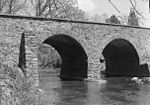The First Battle of Bull Run, called the Battle of First Manassas by Confederate forces, was the first major battle of the American Civil War. The battle was fought on July 21, 1861, in Prince William County, Virginia, just north of the city of Manassas and about thirty miles west-southwest of Washington, D.C. The Union Army was slow in positioning themselves, allowing Confederate reinforcements time to arrive by rail. Each side had about 18,000 poorly trained and poorly led troops. The battle was a Confederate victory and was followed by a disorganized post-battle retreat of the Union forces.
Just months after the start of the war at Fort Sumter, the northern public clamored for a march against the Confederate capital of Richmond, Virginia, which was expected to bring an early end to the Confederacy. Yielding to political pressure, Brigadier General Irvin McDowell led his unseasoned Union Army across Bull Run against the equally inexperienced Confederate Army of Brigadier General P. G. T. Beauregard, whose forces were camped near Manassas Junction. McDowell's ambitious plan for a surprise flank attack on the Confederate left was poorly executed although the Confederates, who had been planning to attack the Union left flank, found themselves at an initial disadvantage.
Confederate reinforcements under Brigadier General Joseph E. Johnston arrived from the Shenandoah Valley by railroad, and the course of the battle quickly changed. A brigade of Virginians under a relatively unknown brigadier general from the Virginia Military Institute, Thomas J. Jackson, stood its ground, which resulted in Jackson receiving his famous nickname, "Stonewall". The Confederates launched a strong counterattack, and as the Union troops began withdrawing under fire, many panicked and the retreat turned into a rout. McDowell's men frantically ran without order in the direction of Washington, D.C.
Both armies were sobered by the fierce fighting and the many casualties and realized that the war was going to be much longer and bloodier than either had anticipated. The First Battle of Bull Run highlighted many of the problems and deficiencies that were typical of the first year of the war. Units were committed piecemeal, attacks were frontal, infantry failed to protect exposed artillery, tactical intelligence was minimal, and neither commander was able to employ his whole force effectively. McDowell, with 35,000 men, could commit only about 18,000, and the combined Confederate forces, with about 32,000 men, also committed 18,000.








